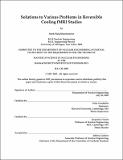Solutions to various problems in reversible cooling fMRI studies
Author(s)
Khachaturian, Mark Haig, 1979-
DownloadFull printable version (2.314Mb)
Alternative title
Solutions to various problems in reversible cooling functional magnetic resonance imaging studies
Other Contributors
Massachusetts Institute of Technology. Dept. of Nuclear Engineering.
Advisor
Wim Vanduffel.
Terms of use
Metadata
Show full item recordAbstract
Functional magnetic resonance imaging (fMRI) has been very useful in helping neuroscientists map the brain. One tool to investigate the interactions between brain regions is to disable a small region in the brain, and look at the functional consequences of this (reversible) inactivation upon regions anatomically connected to the inactivated site. A number of issues need to be resolved before the reversible cooling technique can be used in fMRI studies. The solutions to a number of problems directly related to using reversible inactivation by cooling in conjunction with fMRI experiments on monkey brains are presented in this thesis. Specifically, these include (1) designing a cooling system and cooling probe capable of reversibly cooling the surface cortex of the monkey's brain, (2) develop or use an existing method to measure the temperature distribution with the MR-scanner, and (3) design and construct a coil (phase array) that will be used to obtain temperature and fMRI data at the highest resolution possible. A cooling system and coolant probe were designed capable of changing the temperature of the surface cortex from 37 oC to 20 oC. The Proton Resonance Frequency Shift method, which calculates the temperature based on the phase change between two images, was used to measure the temperature distribution inside an object using an fMRI sequence similar to the one that will be used in the actual experiment. The method was tested and showed an accuracy of ± 0.6 oC as compared with concurrent thermocouple measurements when adjusted for phase drift. A precision of ± 0.15 oC was found at a resolution of 2.1 x 2.1 x 1.0 mm3. A phase array head coil was designed with superior imaging qualities to the current single coil. An increase of SNR from 40 to 52 was observed in the image (30% increase) as compared with the theoretical calculated increase of 70%.
Description
Thesis (S.M.)--Massachusetts Institute of Technology, Dept. of Nuclear Engineering, 2003. Includes bibliographical references (p. 40). This electronic version was submitted by the student author. The certified thesis is available in the Institute Archives and Special Collections.
Date issued
2003Department
Massachusetts Institute of Technology. Department of Nuclear Engineering; Massachusetts Institute of Technology. Department of Nuclear Science and EngineeringPublisher
Massachusetts Institute of Technology
Keywords
Nuclear Engineering.